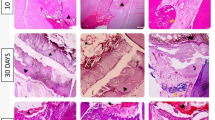Abstract
With the specific aim of the examination of tissue-damage and repair of surgically exposed pulp and periapical region in rat molar model, 14 female Sprague-Dawley rats were used. The coronal portion of lower first molars was surgically removed and the teeth remained untreated for 3 weeks prior to euthanasia of the animals. During this experimental period, all animals were injected with fluorochrome agents twice at the 12th and 19th days, in order to monitor formation of hard tissues in the exposed pulpal chamber and on the surfaces of cementum and alveolar bone. For histologic examination using microradiography and fluorescent and light microscopy, resin-embedded ground sections and serial decalcified sections were prepared. Observations revealed that: (1) over half of the surgically treated teeth gave rise to the formation of osteodentin so that the exposed pulp was partially covered; (2) the number of root canals filled with necrotic tissues was less than 25% of the total teeth examined, while the majority comprised vital granulation tissues and newly formed osteodentin, in certain cases with the appearance of odontoblastic cells aligning on the dentin wall; and (3) active deposition of cementum on the root apex and remodeling of alveolar bone were prominent in most of the treated teeth. The overall results support the contention that rat molar pulp has high potential activities for tissue-repair including hard tissue formation after pulpal exposure to the oral enviroment.
Similar content being viewed by others
References
Kakehashi S, Stanley HR and Fitzgerald RJ: The effects of surgical exposures of dental pulps in germfree and conventional laboratory rats. Oral Surg,20: 340–349, 1965.
Stashenko P, Wang CY, Riley E, Wu, Y, Ostroff G and Niederman R: Reduction of infection-stimulated periapical bone resorption by the biological response modifier PGG glucan. J Dent Res,74: 323–330, 1995.
Tsuji T, Takei K, Inoue T, Shimono M and Yamamura T: An experimental study on wound healing of surgically exposed dental pulp in germ-free rats,28: 35–38, 1987.
Inoue T and Shimono M: Repair dentinogenesis following transplantation into normal and germ-free animals, PROC FINN SOC,88: 183–194, 1992.
Stashenko P, Wang C-Y, Tani-Ishii N and Yu SM: Pathogenesis of induced rat periapical lesions, Oral Surg Oral Med Oral Pathol,78: 494–502, 1994.
Bando Y and Nagayama M: Odontogenic cyst induction by periapical infection in rats, J Oral Pathol Med,22: 323–326, 1993.
Author information
Authors and Affiliations
Rights and permissions
About this article
Cite this article
Sun, XJ., Yagishita, H., Ookubo, S. et al. Histopathologic changes in the pulpal and periapical tissues after surgical removal of the coronal pulp chamber of rat lower molar. Shigaku = Odontology 85, 419–427 (1997). https://doi.org/10.1007/BF03039038
Issue Date:
DOI: https://doi.org/10.1007/BF03039038




